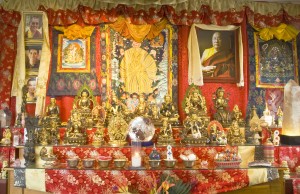The following is an excerpt from a teaching by Jetsunma Ahkon Lhamo called “Keeping Heart Samaya”
When we examine the student’s responsibility in the teacher/student relationship, we have to think like this: First of all, according to the teaching, the lama, as the spiritual teacher or spiritual master, is the condensed essence of the external and most familiar objects of refuge–the Buddha, the Dharma and the Sangha. So, regarding the student’s samaya or commitment to the teacher, there are three aspects of commitment.
As the lama is the condensed essence of Buddha, Dharma and Sangha, the first commitment is to honor and uphold the Buddha’s teachings. That is to say that if we are practicing the Buddhadharma, we should never disrespect the Buddhist prayers and the Buddhist text. We love and respect them as the Buddha’s own speech, the Buddha’s own speech emanation. We should never throw them around or put them under our seats or step on them or treat them as though they were any like other object in samsara, like a rag or something. We should never treat any objects that are representative of the objects of refuge like that, such as statues, Dharma texts, and images of the Buddhas.
It’s not that Buddhists have a superficial, external, worship of images. It is not like that. This rule or practice is meant to develop discrimination in the student’s mind so that the student can discriminate between what is precious and extraordinary and what is ordinary. Ordinary things are things that arise in samsara and result in samsara, even things that we need, like enough water to live on. Water is in the world, you can get it from the world and it results in the satisfaction of worldly thirst. Water is not the same as Dharma. Dharma arises from the mind of enlightenment, results in enlightenment and is not ordinary. Water will support my life temporarily, so it is impermanent. If I drink a glass of water and then don’t drink any more, I will last four or five days. But even though it may be necessary for me to drink that water in order to stay alive long enough to read the Buddha’s teaching, I won’t forget the teaching because it is extraordinary and does not arise from samsara.
This commitment not only supports my life temporarily and in this moment, but it also provides a path or a method by which I can accomplish Dharma, by which I can enter into the door of liberation and be free. This is a miracle. This is a treasure that doesn’t only last one life or one moment or four days. Life after life after life this treasure lasts,. So these things are held up as extraordinary. Part of the student’s commitment to the student/teacher relationship is to honor this external object of refuge–the Buddha image, to honor the Buddha’s presence in the world, to propagate the teaching, to hold it up and protect it.
Copyright © Jetsunma Ahkon Lhamo. All rights reserved











